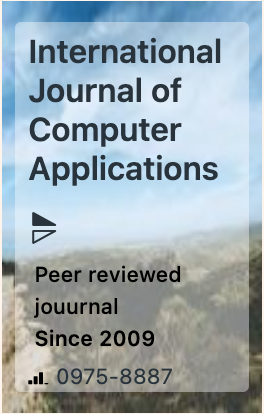The week's pick
Random Articles
Reseach Article
One Cycle Policy-Enhanced Transfer Learning for Robust Bengali Handwritten Character Recognition
| International Journal of Computer Applications |
| Foundation of Computer Science (FCS), NY, USA |
| Volume 187 - Number 51 |
| Year of Publication: 2025 |
| Authors: Raihan Tanvir |
 10.5120/ijca2025925832
10.5120/ijca2025925832
|
Raihan Tanvir . One Cycle Policy-Enhanced Transfer Learning for Robust Bengali Handwritten Character Recognition. International Journal of Computer Applications. 187, 51 ( Oct 2025), 1-6. DOI=10.5120/ijca2025925832
Abstract
The recognition of handwritten Bengali characters presents significant challenges due to the script’s morphological complexity, including visually similar conjunct characters and subtle distinguishing features such as dots or lines, compounded by variations in handwriting styles. To address these challenges, an efficient transfer learning framework is proposed for Bengali Handwritten Character Recognition (BHCR), leveraging advanced deep learning methodologies. A pretrained ResNet-50 model, originally trained on the ImageNet dataset, is fine-tuned with the One Cycle Policy for cyclic learning rate optimization to expedite convergence. Evaluation on the Ekush dataset, comprising 367,018 isolated handwritten characters, demonstrates that the proposed method achieves an accuracy of 95.78% after 50 epochs, surpassing many comparable techniques in efficiency while minimizing architectural overhead.
References
- Mithun Biswas, Rafiqul Islam, Gautam Kumar Shom, Md. Shopon, Nabeel Mohammed, Sifat Momen, and Anowarul Abedin. Banglalekha-isolated: A multipurpose comprehensive dataset of handwritten bangla isolated characters. Data in Brief, 12:103 – 107, 2017.
- D. C. Cireşan, U. Meier, and J. Schmidhuber. Transfer learning for latin and chinese characters with deep neural networks. In The 2012 International Joint Conference on Neural Networks (IJCNN), pages 1–6, 2012.
- J. Deng, W. Dong, R. Socher, L.-J. Li, K. Li, and L. Fei-Fei. ImageNet: A Large-Scale Hierarchical Image Database. In CVPR09, 2009.
- Kaiming He, Xiangyu Zhang, Shaoqing Ren, and Jian Sun. Deep residual learning for image recognition. CoRR, abs/1512.03385, 2015.
- Diederik P. Kingma and Jimmy Ba. Adam: A method for stochastic optimization, 2017.
- Farjana Omee, Shiam Himel, and Md. Abu Naser Bikas. A complete workflow for development of bangla ocr. International Journal of Computer Applications, 21:1– 6, 05 2011.
- Anita Pal and Dayashankar Singh. Handwritten english character recognition using neural network. International Journal of Computer Science & Communication, 1(2):141–144, 2010.
- AKM Shahariar Azad Rabby, Sadeka Haque, Md. Sanzidul Islam, Sheikh Abujar, and Syed Akhter Hossain. Ekush: A multipurpose and multitype comprehensive database for online off-line bangla handwritten characters. In K. C. Santosh and Ravindra S. Hegadi, editors, Recent Trends in Image Processing and Pattern Recognition, pages 149–158, Singapore, 2019. Springer Singapore.
- Akm Shahariar Azad Rabby, Sadeka Haque, Sanzidul Islam, Sheikh Abujar, and Syed Akhter Hossain. Bornonet: Bangla handwritten characters recognition using convolutional neural network. Procedia Computer Science, 143:528 – 535, 2018. 8th International Conference on Advances in Computing & Communications (ICACC-2018).
- Leslie N. Smith. A disciplined approach to neural network hyper-parameters: Part 1 - learning rate, batch size, momentum, and weight decay. CoRR, abs/1803.09820, 2018.
- Abdul Kawsar Tushar, Akm Ashiquzzaman, Afia Afrin, and Md. Rashedul Islam. A novel transfer learning approach upon hindi, arabic, and bangla numerals using convolutional neural networks. In D. Jude Hemanth and S. Smys, editors, Computational Vision and Bio Inspired Computing, pages 972–981, Cham, 2018. Springer International Publishing.
Index Terms
Keywords

